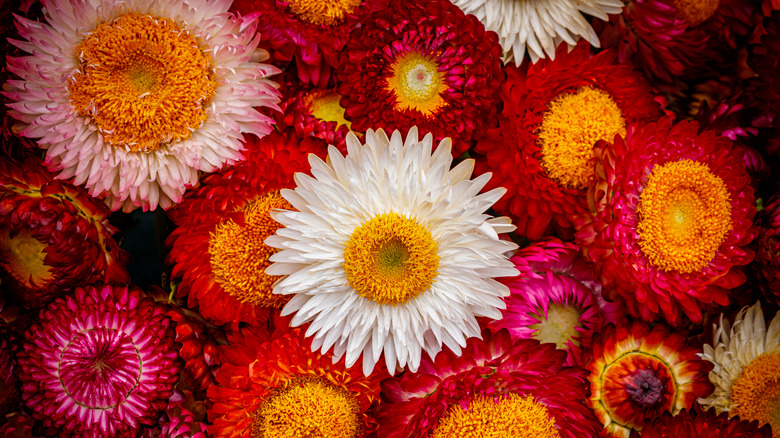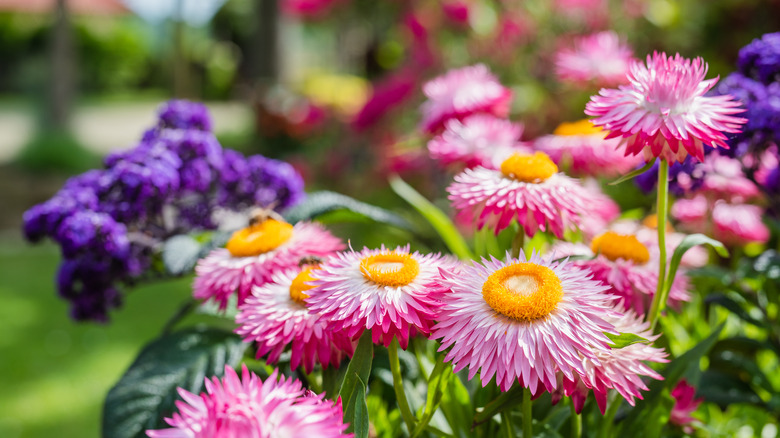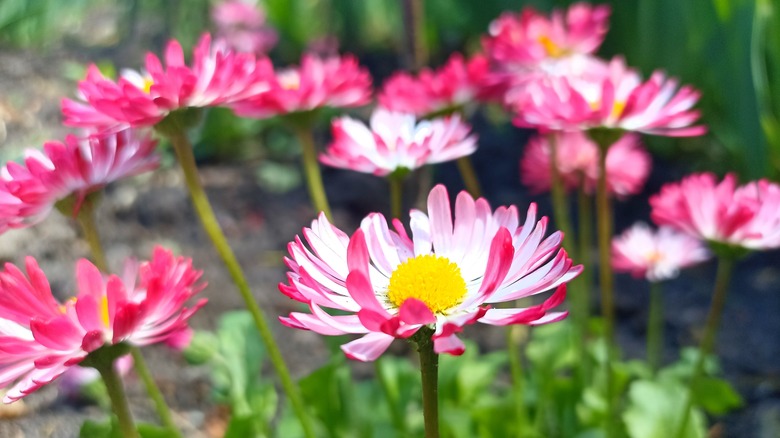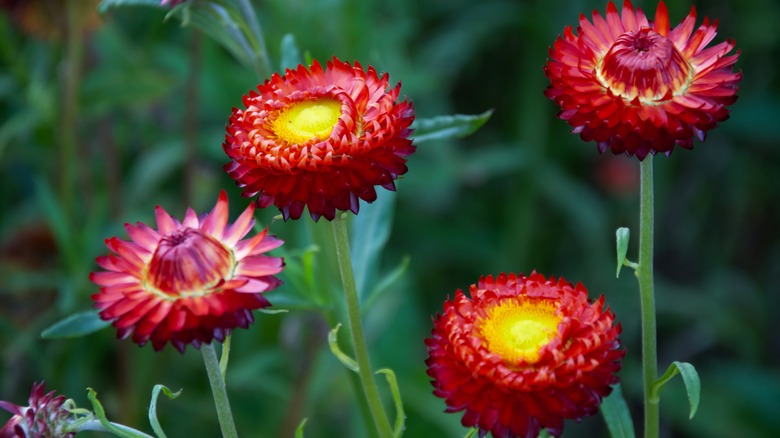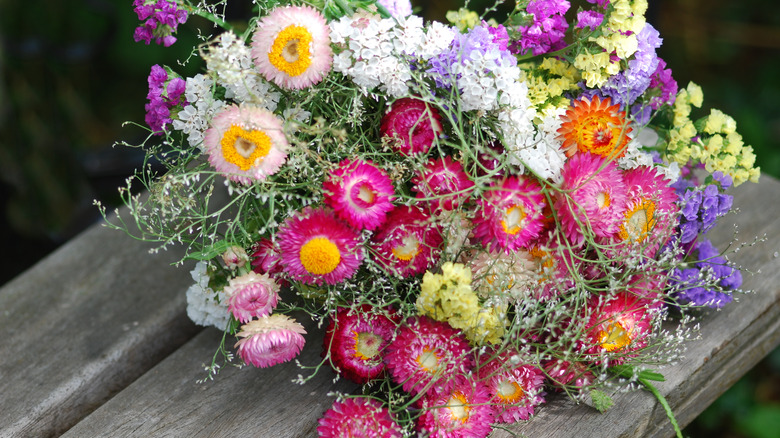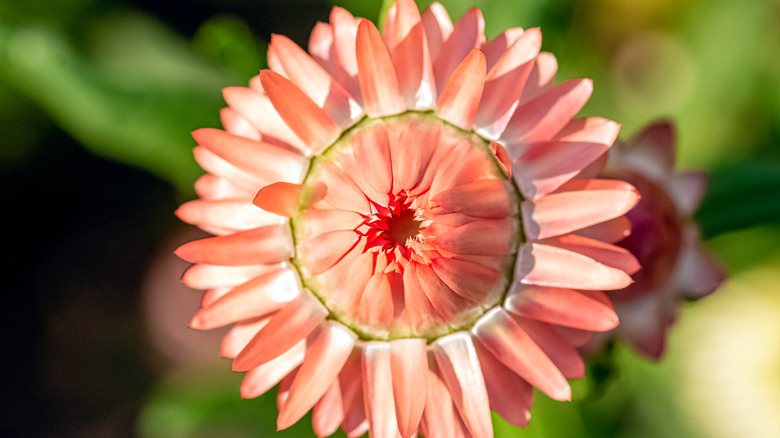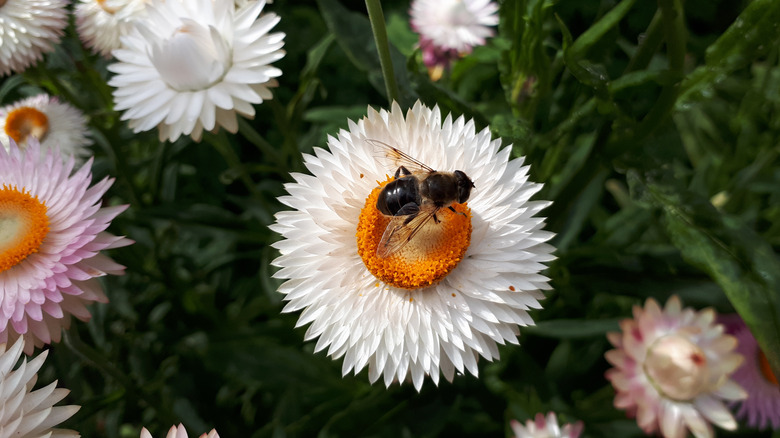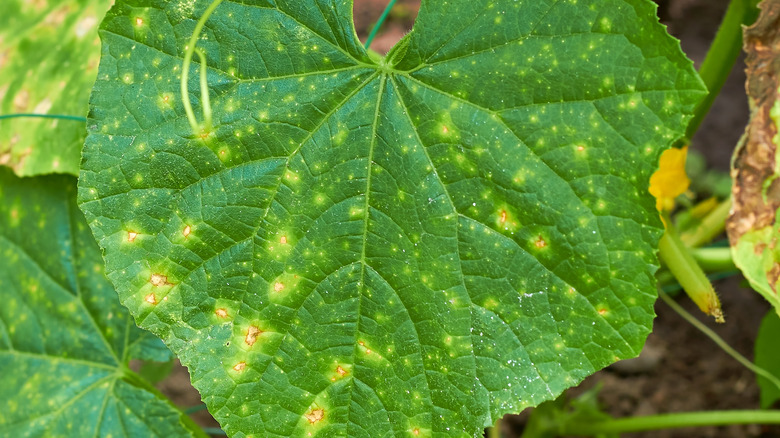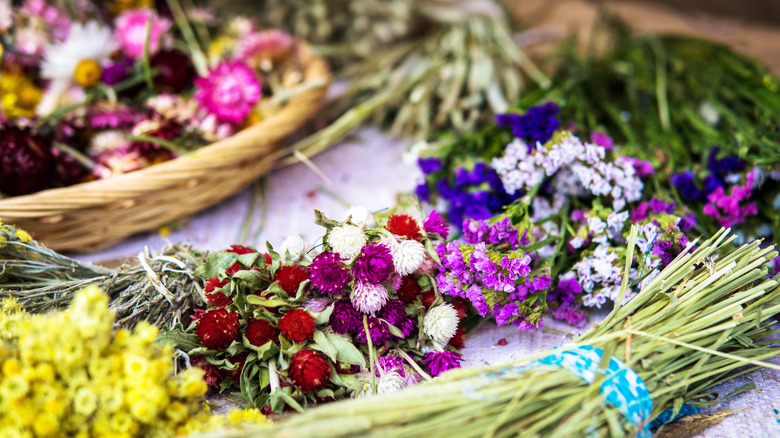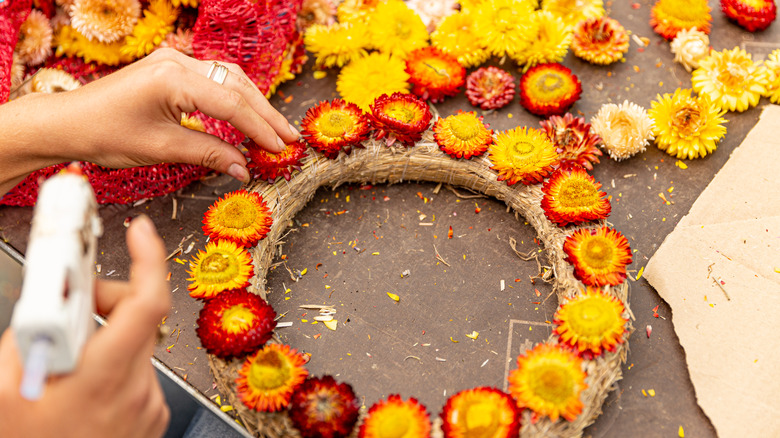How To Grow And Care For Strawflowers
Strawflowers are botanically classified as Xerochrysum bracteatum, although they were formerly grouped within the Helichrysum genus, so you may still find them with that name. According to the North Carolina State Extension Gardener, they get the first half of their botanical name from combining xeros and chrysos; when translated from the Greek those mean dry and golden, respectively. That brings us around to one of this flower's many nicknames, everlasting gold. Strawflowers are also commonly called everlasting daisies and simply everlasting flowers because their straw-like bracts and almost rigid petals retain both their shape and profuse coloring long after they've been harvested. This makes them a popular choice for dried arrangements.
Considering the environmental conditions of their native grasslands in Australia, these plants can be kept as perennials in similar USDA hardiness zones eight, nine, and ten. Outside of that range you'll likely only be able to keep them alive as summer annuals. As their cheerful blooms grace your garden in bright oranges, pinks, reds, and yellows, they'll attract all sorts of pollinators to the party too.
In terms of size, strawflowers shoot up to a height of anywhere from 1 to 5 feet, with dwarf varieties at the low end of that spectrum and most average plants topping out at around 3 feet tall. Lance-shaped green and grayish leaves will be around 5 inches long, and individual blossoms will be on the smaller side, usually about an inch across. Regardless of their petite diameter, each blossom will be vibrantly hued and noticeable. Strawflowers are generally easy to grow, deer-resistant, and particularly tolerant to high heat. These characteristics combine to make them a fun and whimsical addition to your garden, especially if you find yourself in need of plants that will survive summers that are getting hotter and hotter.
How to use strawflowers in the garden or landscape
Because strawflowers can really handle the heat, they're of great use in a landscape with little shade. And, since they come in so many flashy colors, you'll find you can mix and match them in different areas depending on what else you've planted. These abundant producers will stay brightly in bloom from late spring all the way through to the first frost, according to North Carolina State Extension Gardener. That makes them a perfect transition plant to maintain a swath of color in the garden as the early spring annuals cease blossoming and the late summer bloomers have yet to arrive.
New Garden Landscaping & Nursery suggests their 12 inch tall 'Dreamtime Jumbo Red Ember' varietal for a border garden. Their dwarf height makes them suitable for the front row, but remember that other strawflower varieties can grow as high as 5 feet. A staggered array of heights would fill out a mass planting with a veritable rainbow of hues, although you might find that the taller stalks require staking. In the garden bed, give a minimum of 9 inches of space between each planting, so they have room to stretch out as they mature.
New Garden also says strawflowers grow and look great in hanging baskets. When positioning multiple different plants for a thriller/spiller/filler arrangement (via Love Your Plants) they dutifully perform the roll of filler with an upright flush of blossoms that will cover the soil and give that thriller center stage. Just keep in mind that anytime you plant flowers in a hanging basket, they'll retain less moisture than those kept in the ground, and, therefore, require more consistent watering. Strawflowers can withstand air pollution, so definitely consider them if you live in an urban or inner city area.
How to grow strawflowers
Strawflowers grow best when propagated by seed. Per Burpee, seeds must be sown as much as two months before the last frost, so you'll be starting them indoors unless you live in a warm climate zone. You also have the option of waiting until any threat of frost has passed and sowing seeds directly into your garden beds.
Seeds should stay very close to the surface of the growing medium in order for them to receive enough light to germinate; direct sun or fluorescent grow lights should work equally well, but refrain from using incandescent bulbs which will get too hot. Maintain an evenly-moist consistency in the grow pots for the first week to 10 days until sprouts start to shoot up. These seedlings will need 16 hours of light exposure followed by 8 hours of darkness to mimic nighttime. If you're using indoor grow lights, remember to raise them up as the seedlings get taller to avoid heat damage such as burn marks.
Check for roots growing out of the bottoms of smaller grow pots. It's possible that your seedlings will need larger pots for a short period time before they're ready to move outdoors. Bring young plants outside gradually and keep them sheltered from intense sun and high wind until they acclimate to their new conditions. This period of hardening is believed to improve cell structure and reduce overall shock.
For those who like to seed straight into the garden, Burpee recommends working a soil conditioner into the top 6 to 8 inches of the soil first. Sow seeds close to the surface again and cover with only a light dusting of soil. An inch or two of pollinator-friendly mulch is another option for retaining moisture and improving overall soil quality.
How to care for strawflowers
Strawflowers are definite candidates for deadheading. Rather than allowing your flowers to go to seed early, regularly pruning away dead or dying blossoms will encourage this plant to keep offering you more flowers throughout the season. You can refrain from deadheading as the season comes to a close, and then either collect seeds for the following year or simply allow them to disperse themselves around the ground, says Gardenary.
According to the Australian Native Plants Society, strawflower maintenance will rarely call for extensive pruning. However, it can be helpful if you have a plant that is becoming too leggy. Per Patch Plants, this problem results in exceptionally tall plants with only a few leaves at the very top of each stem, and it usually occurs when they are stretching to find adequate light exposure. It can also happen if you don't give them at least an occasional moderate pruning.
In regards to fertilizing, Costa Farms explains that strawflowers will perform just fine without any, but you will get even more blooms with a regular application of general all-purpose food. You could also opt for slow-release granular fertilizer. In that case, simply apply it once when you're getting your plants into the ground and you should be good to go for the season.
Since they are otherwise easy to grow and tolerant of everything from urban pollution to varying pH levels within the soil and moderate periods of drought, there's really not much else to do when it comes to taking care of your strawflowers. Enjoy their bursts of color. Delight in the pollinating visitors they bring to your yard. And, when they're ready, cut a fresh bunch for a bouquet to place in your foyer or to give away as a gift.
Repotting and container growing strawflowers
If you decide to permanently transplant your seedlings or mature plants into containers, stick to a 12 inch dwarf variety or, at the very least, one that's not prone to growing 5 feet tall. Do whatever you can to reduce transplant shock when repotting. Tips to minimize root disturbance include being very gentle when removing a plant from its original pot to avoid breakage of healthy roots, only trimming when necessary, and working quickly and efficiently to reduce the time the roots remain exposed.
An important tip from Growing in the Garden (via YouTube) is to bury your transplant to the same depth it was at in its original pot. This means providing a hole that is only slightly bigger than the root ball you removed and being careful not to cover it with too much soil once it has been moved.
It can be tempting to fill containers with as many flowers as possible, but proper spacing is crucial because of the limited amount of available room. Plants that become crowded will be forced to vie for nutrients and sunlight as well. If you're mixing different kinds of plants and flowers together, opt for varieties that have similar soil and maintenance requirements.
Finally, remember their role as a natural filler plant in the thriller/spiller/filler hanging basket trio. The same rules apply nicely to larger containers at ground level. Love Your Landscape explains that this technique for layering plants with differing proportions creates a three-dimensional experience that far outshines a simple bucket of any old flowers.
Strawflower varieties
When it comes to varieties of strawflowers, hybrid cultivars will primarily differentiate in flower color and overall height. At the garden center you should see their genus (Xerochrysum) and species (bracteatum) clearly marked on the label, followed by a hybrid identifier like 'Copper Red' or 'Lemon Princess'. Other very similar varietal hues include golden yellow and apricot/peach.
Seed companies and nurseries have come up with all sorts of varying shades for these flowers, all of which retain their best qualities of being low maintenance and tolerant of not just drought and soil conditions, but deer and poor air quality as well. Growers from Westhoff Flowers in Germany have gone to great lengths to breed hybrids with only the most durable and disease-resistant genes. According to Greenhouse Product News Magazine, the Westhoff Cottage Series of strawflowers is superior to the rest. They are even adept at handling either warm or cool temperatures, so they are now grown and sold for both spring and fall seasonal plantings. You'll be able to find these flowers in a range of colors including 'Cottage White', 'Cottage Pink', 'Cottage Bronze', 'Cottage Rose' and 'Cottage Yellow'.
Are strawflowers toxic to humans and pets?
There's good news regarding strawflowers and toxicity when ingested by humans or animals, particularly cats, dogs, and horses. They are not included on any of the major lists of poisonous plants, which means they're highly unlikely to cause serious health issues if accidentally swallowed. Daily Paws points out that it's important to remember any plant can make an animal feel mildly sick, especially if they've been munching on quite a few. Temporary gastrointestinal distress is the most common side effect, generally in the form of vomiting or diarrhea.
Smoky Bear Ranch in Glacier National Park adds that when you're out for a hike, you'll come across all sorts of wildflowers in nature. On any given afternoon, you could easily pass a dozen different types, some of which will be safe and others that will be poisonous. Our dogs can't tell the difference, and more often than not, neither can we. It's important to never allow your pets to get into the habit of eating large quantities of plants because the one time they get into something that could really harm them, they could easily eat too much and suffer tremendously.
Common pests and diseases with strawflowers
Overall, strawflowers are known to be robust disease- and pest-resistant plants. One issue they will occasionally have, per University of California Agriculture and Natural Resources (UCANR), is downy mildew. There are two different types of downy mildew (Plasmopara halstedii and Bremia lactucae), but it doesn't matter which one you're dealing with, since they both do the same type of damage and require the same treatment.
Downy mildew is not the same as powdery mildew, though; in order to thrive it requires high humidity in cool temperatures. You'll recognize it by white or pale purple spots on the underside of leaves called sporulation. As the disease worsens, the spots will appear in yellowish blotches on the tops of the leaves. Let untreated, downy mildew can kill a plant or become a systemic issue that stunts growth and/or causes the plant to become malformed and discolored.
Regarding treatment of downy mildew, UCANR advises fungicides but notes that they are unlikely to be labeled specifically for use with strawflowers. Speak to someone at a local garden center to make sure you're purchasing an effective product. A less common fungal infection called verticillium wilt, caused by the Verticillium dahliae fungus, causes yellowed and wilting leaves, usually on the lower part of one side. It's possible that soil treatments containing chloropicrin, which gets added to sulfuryl flouride, can be helpful in fighting this fungus, according to the National Pesticide Information Center.
The aster leafhopper is one of the only insects that bother Xerochrysum bracteatum by transmitting the aster yellows disease, says the Connecticut Agricultural Experiment Station. The pesticide used to control them is called carbaryl, which can be found in many commercial products. Maintaining young plants within a fine-screened cage can also help; as will imidacloprid applied to the root system.
Strawflower cut floral bouquets and wiring technique
One of the nicknames for strawflowers is everlastings, and that is the primary reason why they are so popular in cut flower gardens, bouquets, and crafts. Their bold colors simply do not fade over time. In her guide to quick and easy garden flower arrangements, Angela from Growing in the Garden puts strawflowers in the disk flower category. Then she pairs them with flowers from other categories such as roses (focal flowers), amaranth (spike flowers), and verbena (filler flowers). Similar to the way you can arrange containers with plants that represent different heights and structures, you can build layers into your cut flower bouquets.
To get the longest vase life out of your strawflowers, use sharp shears for a clean cut and to avoid the risk of crushing and damaging the stems. Cut your flowers early in the day when they are still cool and well-hydrated. Strip everything but the top third of the leaves. Place your stems in a clean bucket or vase and give them an hour to soak up some more water before arranging them.
If anyone is curious on how best to wire strawflowers for use in craft projects, Young Blooms Floristry School recommends starting with fresh instead of dried flowers so that the stems are supple and easy to work with, as opposed to being brittle (via YouTube). For this technique, cut the stems very short and insert a long piece of 19 gauge wire into it while it is still fresh. Let the wire poke up an inch above the top of the flower. Then fold it back onto itself and pull the loop you've just made back down through the flower. With that you will have created a usable flower for arrangements and various design projects.
Using strawflowers in craft projects
Strawflowers dry and retain vibrancy so well they are a staple in the world of dried flower crafts. To preserve your bouquet, first pick one of the methods laid out by MasterClass. For the patient traditionalists, there's air drying, which can take up to a month. For a quicker process, flowers can be baked for several hours at a low temperature in the oven. The downfall here is potential loss of color and petals.
A heavy object can be employed to literally press the moisture out of a bouquet, but then you'll be left with squashed flowers best used to make stationary. Finally, so long as you don't mind dragging Mr. Mitten's kitty litter into the kitchen, you could always heat your flowers in the microwave with a bowl of desiccant, the term used to describe substances that induce dryness, such as cat litter and silica gel.
Once you've got your dried flowers ready to go, consider making the gorgeous, easy-to-DIY strawflower wreath offered up by the brother and sister duo Alexandra and Michael Scholtz at WildFlora Design. Start by choosing your color theme. The reds, oranges, and yellows will work perfectly for a fall-inspired Thanksgiving wreath for the front door or mantel, but you could also stick to blossoms in the maroon, pink, or white scope. The only other supplies you'll need are an adhesive (glue gun or craft glue both work great) and your base wreath, whether that be twigs you gather in the yard and twist together or a simple blank circle you buy at the store.
Invite a friend over, make some tea, and laugh and chat as you work your way around the wreath attaching individual flowers. Once the glue is dry, it will be ready to display.
